I’ve always wanted to make a corn husk doll. These little figures are traditionally created at harvest time and have a long history in many civilizations including Northern European, Central European and North American native. Children often construct crude corn husk dolls. I just think they are sweet and make great decorations. After some serious research online, I gathered enough information to try making a doll.
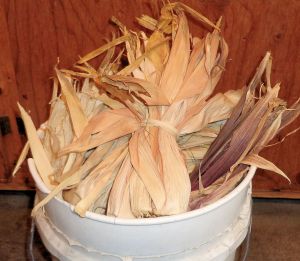
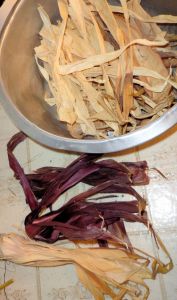 Since I grow indian corn, there are always plenty of husks. I saved a couple buckets full, both white and red corn husks. The silk would make great doll hair, but I’ve always fed that to the horses. In the future I’ll dry and save that for dollmaking.
Since I grow indian corn, there are always plenty of husks. I saved a couple buckets full, both white and red corn husks. The silk would make great doll hair, but I’ve always fed that to the horses. In the future I’ll dry and save that for dollmaking.
I found a good supply of tightly curled ringlets of tendrils on the dried squash and gourd vines from last summer. These will make great curly hair for a doll. To tie the husks, I’ll use hemp baling twine and I found some thin pieces of corn stalk that can be used to make a broom handle for the doll to hold.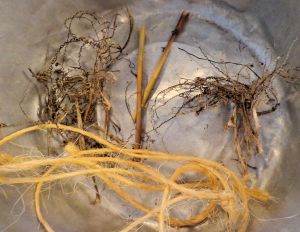
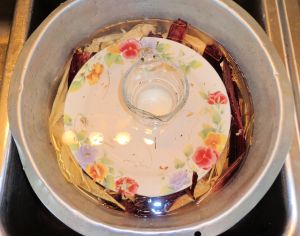 The dried corn husks are soaked for 10-15 minutes in warm water. Husks must be dried before use so they will not be too wet and mildew and also not be too brittle and crack. Drying makes the husks tough and soaking them gives a nice pliable material. I weighted the husks down with a plate and cup of water because they float.
The dried corn husks are soaked for 10-15 minutes in warm water. Husks must be dried before use so they will not be too wet and mildew and also not be too brittle and crack. Drying makes the husks tough and soaking them gives a nice pliable material. I weighted the husks down with a plate and cup of water because they float.
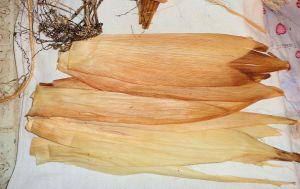 Gathering 8-10 long, full pieces of husk, I blotted them dry, lined up the pointed ends, placed the bundle of gourd tendrils on the inside and tied the end tightly with string.
Gathering 8-10 long, full pieces of husk, I blotted them dry, lined up the pointed ends, placed the bundle of gourd tendrils on the inside and tied the end tightly with string.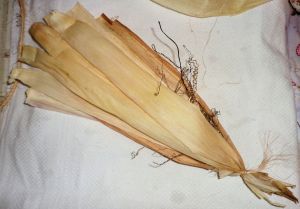
Next, I flipped the stalks around to form the hair and top of the head. There is enough material inside the bundle of husks to fill out the head.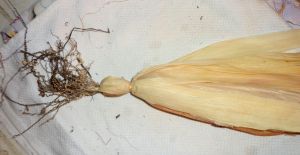 I smoothed the husk in one area to make a nice face and tied the neck tightly. The ends of the husks are cut straight to form the bottom of the doll’s dress.
I smoothed the husk in one area to make a nice face and tied the neck tightly. The ends of the husks are cut straight to form the bottom of the doll’s dress.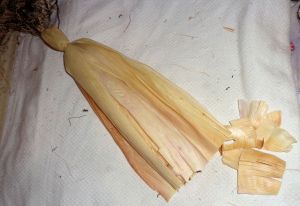 This is her petticoat, a creamy beige color. To make the arms, a slim piece of husk is rolled tightly and trimmed to about 6″ long. Two pieces of red husk about 5″ square are cut for the sleeves.
This is her petticoat, a creamy beige color. To make the arms, a slim piece of husk is rolled tightly and trimmed to about 6″ long. Two pieces of red husk about 5″ square are cut for the sleeves. The red husk is bunched around the end of the rolled piece, about 1/2″ from the end.
The red husk is bunched around the end of the rolled piece, about 1/2″ from the end.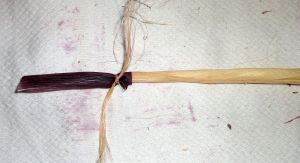 After tying tightly, the red husk is flipped over and the other end tied. This is repeated for the other sleeve.
After tying tightly, the red husk is flipped over and the other end tied. This is repeated for the other sleeve.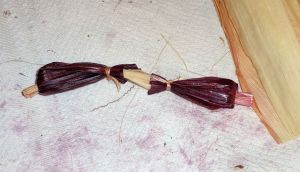
The arm construction is fed up through the bundled husks and the waist is tied tightly to keep the arms in place.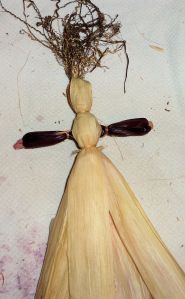
Two slim pieces of red husk are crossed over the body to form shoulders and tied tightly at the waist. These strips cover and fill out the arm area.
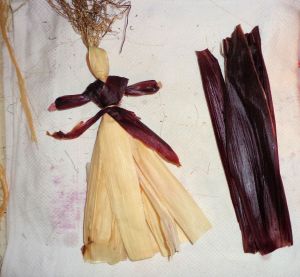
Next, several broad, long red husks are selected for the skirts of the dress. The pointed ends are arranged around the waist, tied tightly, then flipped down.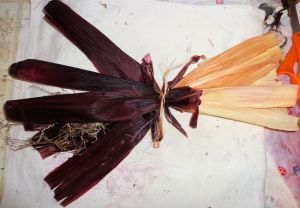
The ends are trimmed again to a straight hem line on the dress.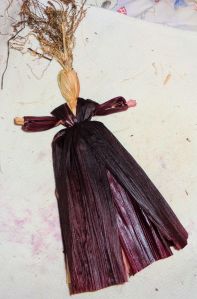
Finally, the hair is pulled down, arranged and I used a slim piece of red husk to make a head scarf since my doll is going to be doing housework.
I fashioned a simple broom by tying 3″ long bunches of baling rope around one end of a small corn stalk. To hold the broom in place, one thin strand of hemp twine that is barely visible is tied around the hands and broomstick.
Most corn husk dolls are not given features due to various superstitions from the cultures that originated the dolls. I prefer a simple face so I sketched one with a fine point black Sharpie pen. The doll stands 9″ tall and once dried, makes a lovely decoration on a small table in my living room.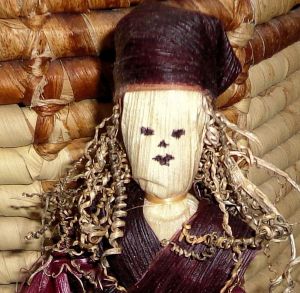
 This was so much fun, I intend to make more. In the future I will use double or triple the number of corn husks for the petticoats and skirts to make them fuller. This doll is made entirely from natural materials except for the facial features I drew in with the pen.
This was so much fun, I intend to make more. In the future I will use double or triple the number of corn husks for the petticoats and skirts to make them fuller. This doll is made entirely from natural materials except for the facial features I drew in with the pen.
Children adore fashioning these dolls and I think this will be a great activity to do with my granddaughter. The doll does not have to be so elaborate. Often the arms are merely braided lengths of husk tied at the ends. Boy dolls are made by separating the skirts and forming two pant legs tied at the ankles. Sometimes legs are braided to go inside the pants. These would be tied on at the waist before the final layer of husks.
I have named my doll Maizie, not original, but apt.

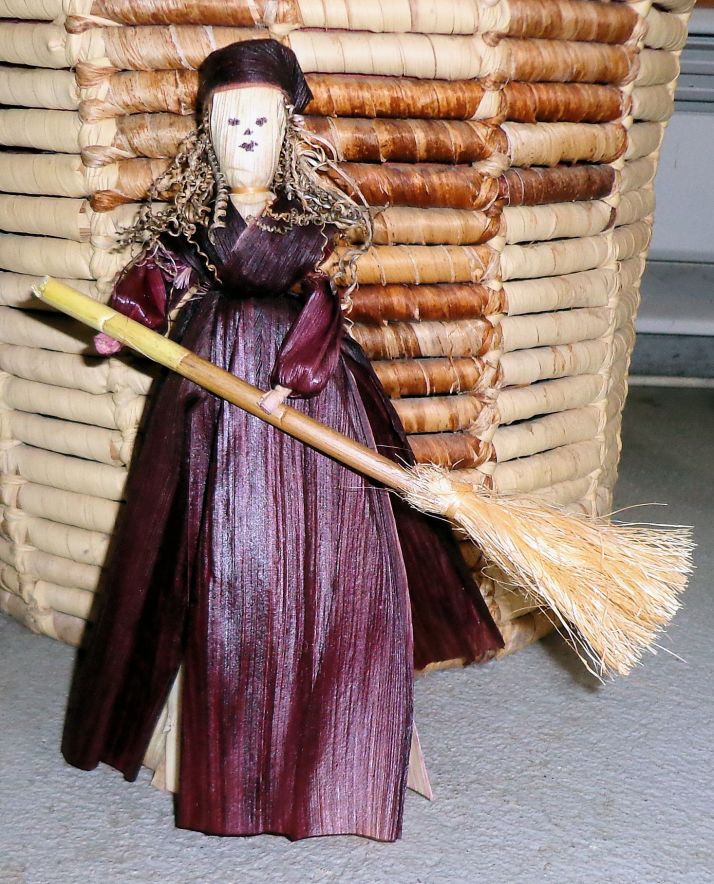
Maisie is a real beauty. I like the red husks used to dress her. Very well made, darling!
Thanks Mums! I like the red husks too.
She came out really nicely! Looks like quite a process.
Thanks! Once you get into making it, the work goes pretty fast.